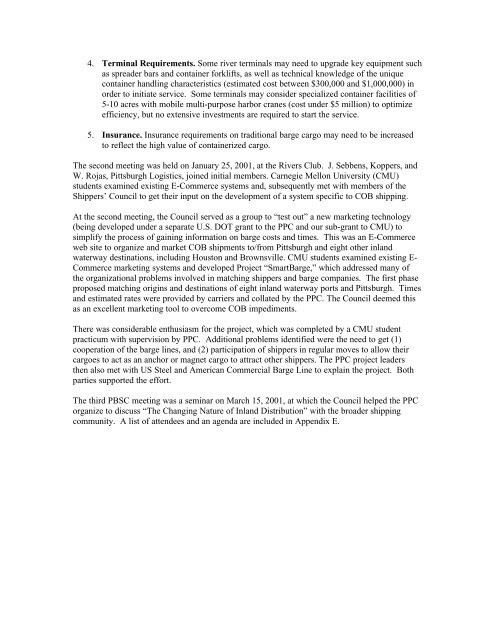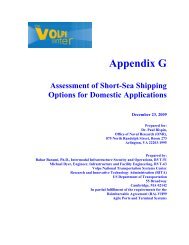Container-on-Barge Pre-Feasibility Study Final Report - Towmasters ...
Container-on-Barge Pre-Feasibility Study Final Report - Towmasters ...
Container-on-Barge Pre-Feasibility Study Final Report - Towmasters ...
You also want an ePaper? Increase the reach of your titles
YUMPU automatically turns print PDFs into web optimized ePapers that Google loves.
4. Terminal Requirements. Some river terminals may need to upgrade key equipment such<br />
as spreader bars and c<strong>on</strong>tainer forklifts, as well as technical knowledge of the unique<br />
c<strong>on</strong>tainer handling characteristics (estimated cost between $300,000 and $1,000,000) in<br />
order to initiate service. Some terminals may c<strong>on</strong>sider specialized c<strong>on</strong>tainer facilities of<br />
5-10 acres with mobile multi-purpose harbor cranes (cost under $5 milli<strong>on</strong>) to optimize<br />
efficiency, but no extensive investments are required to start the service.<br />
5. Insurance. Insurance requirements <strong>on</strong> traditi<strong>on</strong>al barge cargo may need to be increased<br />
to reflect the high value of c<strong>on</strong>tainerized cargo.<br />
The sec<strong>on</strong>d meeting was held <strong>on</strong> January 25, 2001, at the Rivers Club. J. Sebbens, Koppers, and<br />
W. Rojas, Pittsburgh Logistics, joined initial members. Carnegie Mell<strong>on</strong> University (CMU)<br />
students examined existing E-Commerce systems and, subsequently met with members of the<br />
Shippers’ Council to get their input <strong>on</strong> the development of a system specific to COB shipping.<br />
At the sec<strong>on</strong>d meeting, the Council served as a group to “test out” a new marketing technology<br />
(being developed under a separate U.S. DOT grant to the PPC and our sub-grant to CMU) to<br />
simplify the process of gaining informati<strong>on</strong> <strong>on</strong> barge costs and times. This was an E-Commerce<br />
web site to organize and market COB shipments to/from Pittsburgh and eight other inland<br />
waterway destinati<strong>on</strong>s, including Houst<strong>on</strong> and Brownsville. CMU students examined existing E-<br />
Commerce marketing systems and developed Project “Smart<strong>Barge</strong>,” which addressed many of<br />
the organizati<strong>on</strong>al problems involved in matching shippers and barge companies. The first phase<br />
proposed matching origins and destinati<strong>on</strong>s of eight inland waterway ports and Pittsburgh. Times<br />
and estimated rates were provided by carriers and collated by the PPC. The Council deemed this<br />
as an excellent marketing tool to overcome COB impediments.<br />
There was c<strong>on</strong>siderable enthusiasm for the project, which was completed by a CMU student<br />
practicum with supervisi<strong>on</strong> by PPC. Additi<strong>on</strong>al problems identified were the need to get (1)<br />
cooperati<strong>on</strong> of the barge lines, and (2) participati<strong>on</strong> of shippers in regular moves to allow their<br />
cargoes to act as an anchor or magnet cargo to attract other shippers. The PPC project leaders<br />
then also met with US Steel and American Commercial <strong>Barge</strong> Line to explain the project. Both<br />
parties supported the effort.<br />
The third PBSC meeting was a seminar <strong>on</strong> March 15, 2001, at which the Council helped the PPC<br />
organize to discuss “The Changing Nature of Inland Distributi<strong>on</strong>” with the broader shipping<br />
community. A list of attendees and an agenda are included in Appendix E.
















